A WOLF IN NEW YORK
12 minute read
By Dr Lena Fritsch
Curator of Modern and Contemporary Art
In 2018 the Ashmolean's Curator of Modern and Contemporary Art, Dr Lena Fritsch, was awarded a New Collecting Award by the Art Fund to research and acquire Neo-Expressionist works on paper. In 2020, as part of the project, the Museum was delighted to be able to purchase and add to the collection The Wolf, 1984, and other etchings, by German artist Rainer Fetting.
In autumn 2020, Dr Fritsch visited Rainer Fetting in his studio in Berlin, and they spoke about his works in the Ashmolean's collection. You can read their conversation below.
LF: The Ashmolean recently acquired your etching, The Wolf, 1984. The motif of the wolf can be found in a number of your paintings and works on paper.
RF: This motif is linked to a particular time. My first wolf picture was made as part of the wood pictures, when I mounted wood on top of a painting.
I lived in Manhattan on 23rd Street, between 11th Avenue and West Side Highway, which runs along the Hudson River. In 1983, I had moved to New York. To get fresh air and to get out of the ‘big city jungle’, I used to walk along the Hudson River, enjoying the wideness – you could see as far as to the Statue of Liberty.
Coming from the North Sea, I have always liked the sea. At the time, there were still those old piers at the Hudson and one pier was made of oak wood. It was already falling apart but you were still allowed to walk on it. I took photos there too – some are included in my books.
I created large-sized portraits and self-portraits onto which I mounted wood, and then I came up with the wolf motif. It’s a long time ago and New York was economically pretty run down. I first lived in Williamsburg.
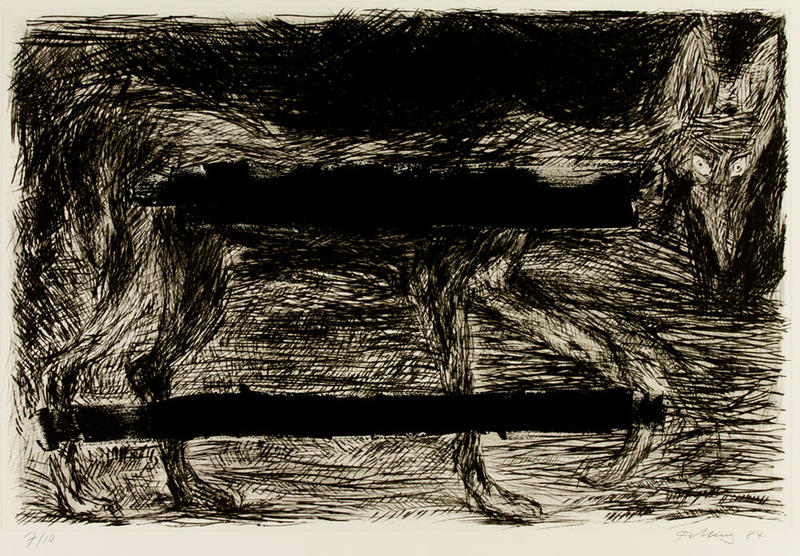
Rainer Fetting (b.1949), Wolf, 1984. © The Artist. Ashmolean Collection. WA2019.103
LF: Williamsburg at the time must have been different from the gentrified ‘hipster’ place it is today!
RF: It was a dangerous area. I lived around the corner from the Orthodox Jewish area but apart from that there was nothing. I was scared when going to the underground station to travel to Manhattan. Today it is very different. Looking out of my window, I used to see these abandoned, straying dogs. It was a wolf-like and homeless atmosphere. The wolf was probably a symbol of that time. I also painted white wolfs with wood mounted on the canvas.
LF: In the etching, the wood is visible as a dark stripe.
RF: Yes. I have always done such things intuitively. It just fitted with the atmosphere and with my emotional situation at the time. I made numerous prints with Frank [Francisco] Copello. But I had worked with the medium much earlier already, when studying at the HdK art school in Berlin. When I received a scholarship for Columbia University and went to New York for the first time, in 1978, I joined the printing class by Jasper Johns’ printer. He was never there though and it was mostly taught by a female supervisor. At that time, I made the Van Gogh and the Wall prints.
LF: In the Ashmolean’s collection there are also three prints from your Portrait of Shaun series from 1989. It’s the same portrait but in different colours, each of them conveying a different atmosphere.
RF: I make use of all possibilities and try all kinds of different things. I have countless test prints as well – I would like to do an exhibition with them at some point. I could do a whole museum exhibition or book just with the test prints of one motif as these were not sold. It is interesting because there are so many different versions.
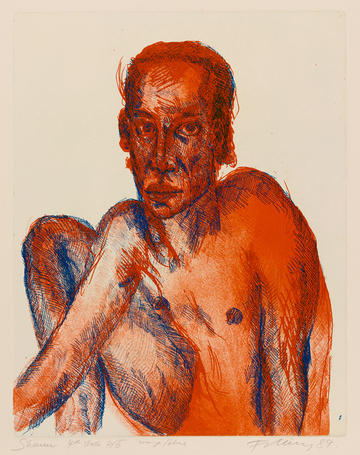
Rainer Fetting (b.1949), Portrait of Shaun, 1989. © The Artist. Ashmolean Collection. WA2019.106
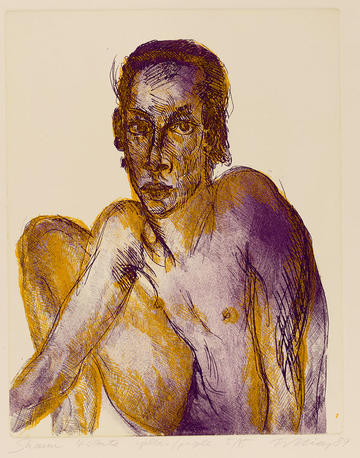
Portrait of Shaun by Rainer Fetting, 1989, 1 of 3 etchings. Ashmolean. © Rainer Fetting
LF: Could you tell me more about Shaun?
RF: Shaun was a good friend of printer Frank Copello at the time. My main model is Desmond [Cadogan] but there was this opportunity to work with Shaun, who was a jazz musician, if I remember correctly. By the way, Frank was also a performance artist. I made paintings of Shaun too.
LF: Did you work with him ‘live’?
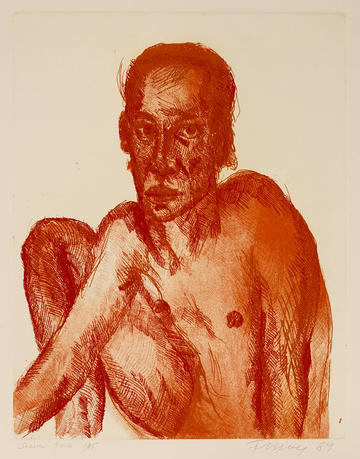
Rainer Fetting (b.1949), Portrait of Shaun, 1989. © The Artist. Ashmolean Collection. WA2019.104
RF: Yes, always. He was always there, had a lot of free time and enjoyed it. Desmond did not have so much time during this period, he worked in the fashion business and art scene.
Today I often work with photographs as I just don’t have the energy anymore. I still work 'live' but only with Desmond, and a few models, when it works out.
In the competitive art scene, it was often said that I just follow my private obsessions. People were not interested in seeing my work as an emancipatory act because it did not fit with the ideological art discourse of the day. I started painting the male erotic figure in the mid ‘70s already, when nobody else did it the way I did and when painting (especially figurative painting) was declared ‘dead’. Now, thirty or forty years later, there are many young painters and they get credits for what I did way earlier – but now it is trendy, especially the representation of the Black male.
LF: For your paintings and prints, do you work with sketches?
RF: No, I usually start directly. For most of the etchings – like these ones with Shaun – I go directly into the plate with the needle.
LF: May I ask why you moved to New York?
RF: For a long time, New York didn’t interest me but then there were two triggers: films and art.
At the time when I lived in Berlin at Moritzplatz, I was really interested in Willem de Kooning’s work. I read all biographies over the years and also researched Jackson Pollock and Mark Rothko. People often link my work to German Expressionism and Die Brücke but that is too one-sided. I was fascinated with Abstract Expressionism too and that is where the large-format of my work comes from. There were all these legends about the Abstract Expressionists in New York, hanging out in Cedar Tavern etc.
At the same time, there were films by Martin Scorsese, like Mean Streets with Robert de Niro – not well-known at the time. The setting was Little Italy. By chance, that’s also where my first apartment in New York was.
It was a culture shock though. Berlin was run down but New York was worse. It was another world. I had not sold so many works and my parents’ support that I received when studying had ended so the scholarship for New York in 1978 was a great opportunity.
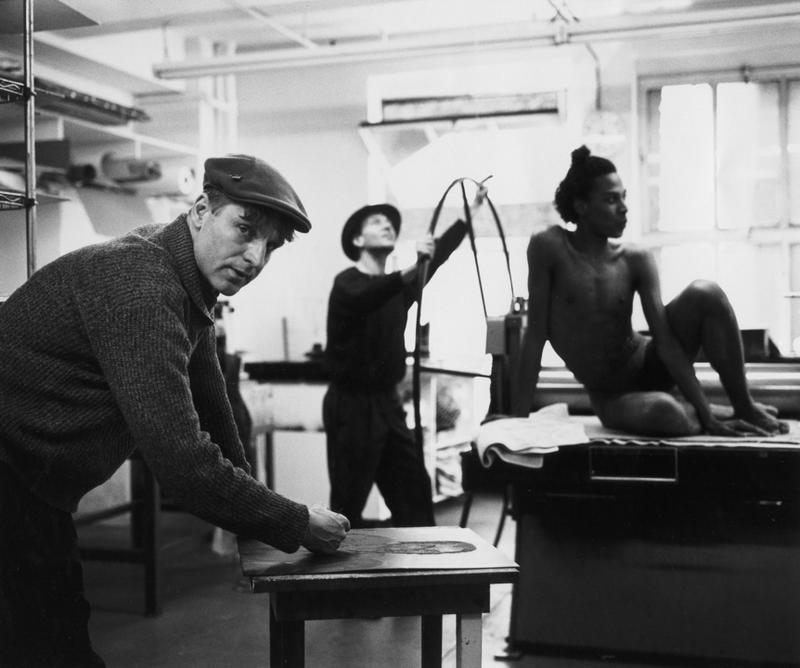
The artist Rainer Fetting, and Shaun, at Frank Copello’s Printshop NY, 1989. Photo: Wolfgang Wesener (WoWe)
LF: In 1983 you moved there again and you stayed for over ten years. Remembering the ‘80s today, how would you describe the atmosphere?
RF: It was a crazy time. I don’t have much time to think about the past though: life goes on and I’m busy with what I’m doing now.
I worked a lot with etchings at that particular time. This also helped the printer, Frank Copello, financially. He had taken over artist Sandro Chia’s workshop on 521 W 23rd street, where I had my loft on the 4th floor, the printing shop was one floor below. Copello then moved to a more affordable neighbourhood nearby, in Times Square, which in those days was totally run-down. The small loft was in the garment district between 36th and 40th Street, between Eighth and Ninth Avenue, where high Art-Deco buildings line the streets. I printed there, for several months.
Frank always needed money – and so did Shaun. But they quickly spent the money on things that they shouldn’t have spent it on. Drugs were often part of the game. After I left New York, Frank could not survive there anymore and moved back to Santiago, Chile. Later I found out that he died of Aids.
LF: How interesting that your printing work helped other people survive.
RF: I’m not a big ‘socializer’. People like Keith Haring, Andy Warhol, Julian Schnabel and Basquiat were big at the time but I was not part of that New York artists scene. I was therefore happy to have contact to others by doing prints. Desmond was not always available as he was part of that scene and would go to every party by Haring etc. He worked in the night scene and also modelled. So for me it was a good time to make these prints. Frank always cooked and it was a nice homely atmosphere. It’s sad that he passed away.
Thank you, Rainer Fetting! We are very happy to have these prints in the Ashmolean’s collection.




